The Trix Indicator offers traders a nuanced perspective on market dynamics by employing a complex calculation methodology that goes beyond simple moving averages. Understanding its key features can provide insights into market trends and potential entry or exit points.
From its TEMA component to divergence analysis, each aspect plays a crucial role in deciphering market sentiment and identifying trading opportunities. By unraveling the intricacies of these seven features, traders can enhance their decision-making process and potentially gain an edge in navigating the complexities of financial markets.
TRIX Calculation Method
Utilizing a sophisticated triple exponential moving average (TEMA) filtration process, the calculation method of the TRIX indicator intricately assesses percentage changes between successive TEMA values to pinpoint significant price fluctuations.
The TRIX indicator, a technical analysis tool, employs a triple smoothing technique that incorporates exponential moving averages (EMA), double exponential moving averages (DEMA), and TEMA.
By focusing on the percentage change in TEMA values, TRIX helps traders in identifying potential trend reversals and generating buy or sell signals based on these changes.
This method allows for a more precise analysis of market movements, filtering out noise and highlighting relevant price shifts.
The TRIX calculation method is crucial in providing traders with a clear and actionable signal line, which aids in making informed decisions in the dynamic financial markets.
Understanding the intricacies of the TRIX calculation process is essential for traders looking to leverage this powerful indicator in their trading strategies.
Triple Exponential Moving Average (TEMA) Component
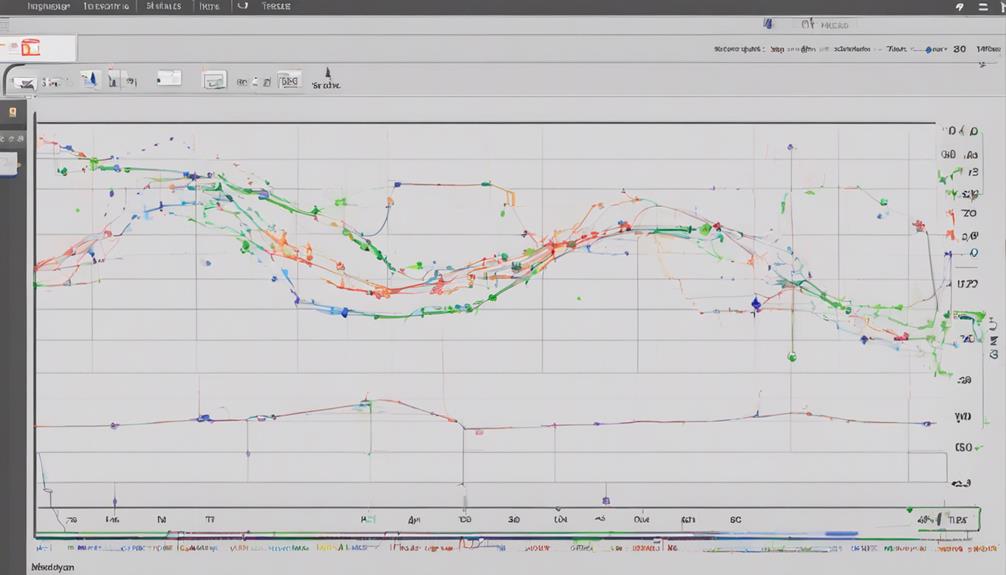
Incorporating a triple smoothing technique, the Triple Exponential Moving Average (TEMA) component is a sophisticated tool utilized for reducing noise and enhancing the accuracy of price trend representation. TEMA is an advanced moving average that involves triple smoothing through the application of three exponential moving averages successively. This technique provides a more responsive and precise depiction of price trends compared to traditional moving averages.
Within the TRIX calculation method, TEMA plays a crucial role in filtering out insignificant price fluctuations, allowing TRIX to focus on identifying significant trend changes. By utilizing TEMA, TRIX can generate reliable trading signals that help traders make informed decisions based on reduced noise and a clearer view of the underlying price movements.
Percentage Change Calculation
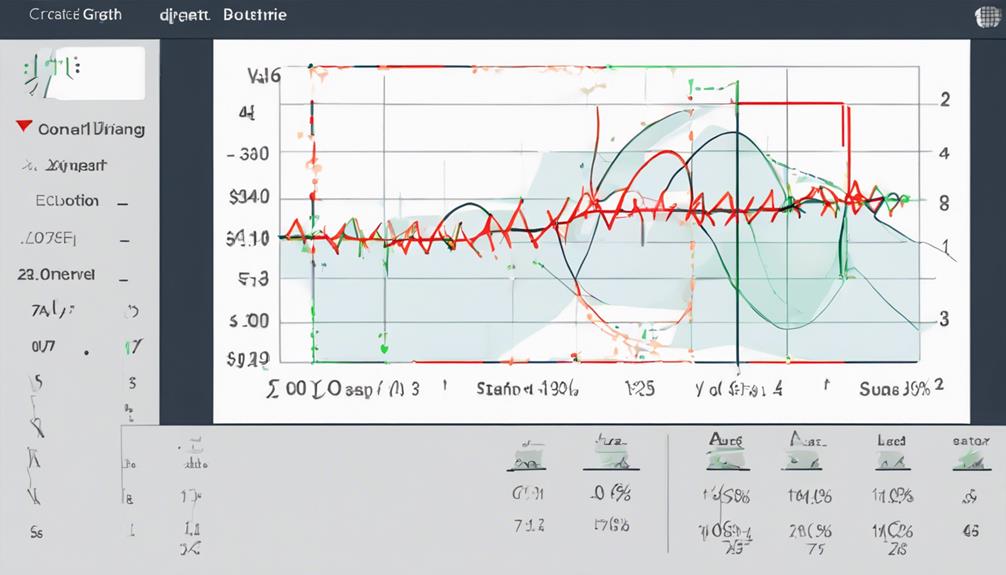
The Percentage Change Calculation in the TRIX indicator involves analyzing the rate of change in the Triple Exponential Moving Average (TEMA) to effectively filter out minor price fluctuations and focus on significant trend movements. By calculating the percentage change in the TEMA, TRIX helps traders identify the momentum and direction of a trend more clearly.
This technical analysis tool utilizes the Exponential Moving Average (TEMA) to provide a smoother and more responsive indicator compared to traditional moving averages, allowing for quicker trend identification. The rate of change measured by TRIX aids in distinguishing meaningful price movements from noise, enabling traders to make more informed decisions.
When the TRIX line crosses above or below the signal line, it indicates potential changes in the trend direction based on the percentage change calculations. This method of analyzing price movements through percentage change calculation is a valuable feature of the TRIX indicator for traders seeking to navigate market trends accurately.
Signal Generation Mechanism
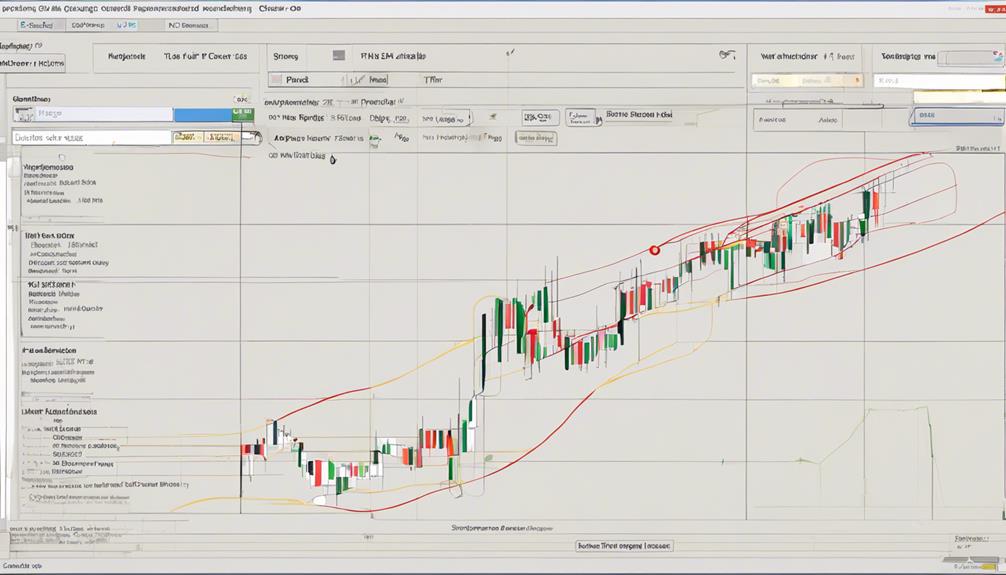
How does the TRIX indicator signal potential entry and exit points in trading?
The Triple Exponential Average (TRIX) indicator employs a signal line to generate buy and sell signals, indicating favorable moments for traders to enter or exit positions.
Here are key points about the signal generation mechanism:
- Buy signals are triggered when TRIX crosses above the signal line.
- Sell signals are initiated when TRIX crosses below the signal line.
- TRIX signal line crossovers serve as essential indicators for identifying entry and exit points in trading.
- Crossovers of TRIX above or below the zero line signify shifts in market momentum and trend direction.
Understanding these signal generation mechanisms is crucial for traders to make informed decisions and implement effective trading strategies that capitalize on market shifts.
Bullish Signal Patterns
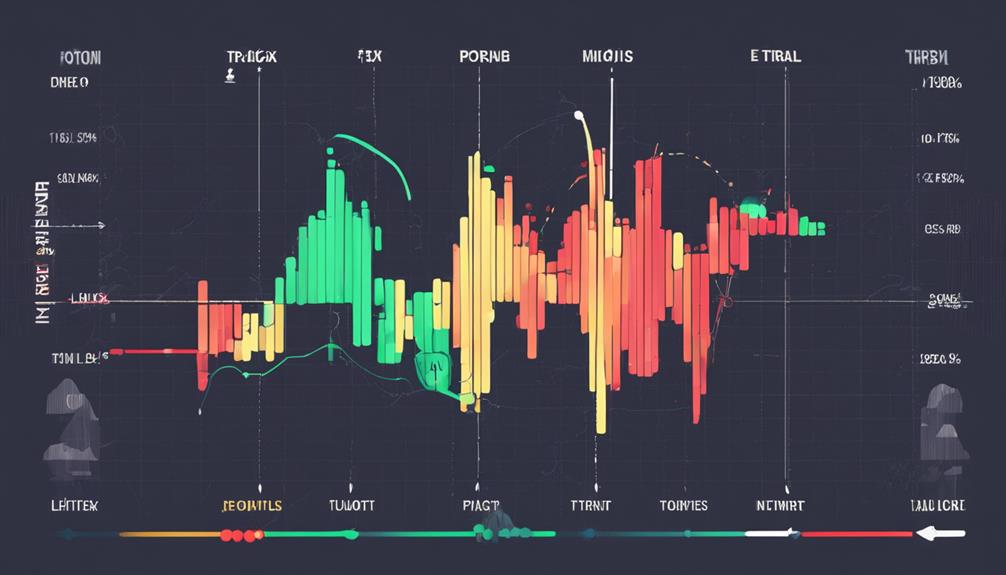
Bullish signal patterns in TRIX are crucial for identifying potential buying opportunities, with the indicator crossing above the zero line being a significant indication.
Positive values in TRIX demonstrate upward momentum and a bullish market trend, making it a valuable tool for traders seeking entry points.
Additionally, a bullish crossover between TRIX and its signal line can strengthen the conviction of a bullish market sentiment, guiding traders in their decision-making process.
Candlestick Formations Analysis
In the analysis of candlestick formations, identifying key bullish signal patterns plays a crucial role in forecasting potential market movements and sentiment shifts. When analyzing candlestick formations for bullish signals, traders look for specific patterns that indicate a potential shift towards bullish sentiment and market reversals.
Some important bullish reversal patterns include Bullish Engulfing, Hammer, and Morning Star. Additionally, patterns like Bullish Harami, Piercing Line, and Three White Soldiers are also significant in anticipating positive price action. Understanding the market psychology behind these bullish candlestick patterns can assist traders in making well-informed decisions regarding their trades.
Analyzing these bullish signal patterns provides valuable insights into potential trend changes and can help traders strategize their entry and exit points effectively.
Entry and Exit Strategies
Analyzing entry and exit strategies based on bullish signal patterns, particularly those involving TRIX crossovers above the zero line, is essential for traders seeking to capitalize on potential market opportunities.
When the Triple Exponential Average (TRIX) crosses above the signal line, it suggests a bullish pattern, indicating potential buying opportunities. Positive TRIX values signify upward momentum and a bullish market trend, aiding traders in identifying optimal entry points for long positions.
Additionally, spotting bullish divergence between TRIX and price action can hint at a possible trend reversal to the upside. These bullish signal patterns play a crucial role in guiding traders towards making informed decisions regarding market entry and exit, leveraging the TRIX indicator as a reliable momentum indicator.
Bearish Signal Patterns
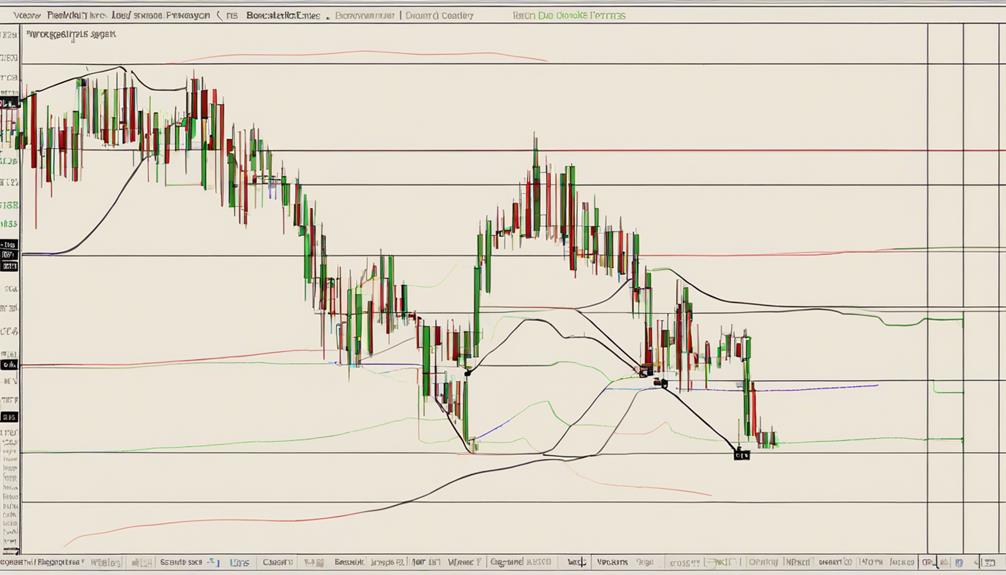
Bearish signal patterns such as Bearish Engulfing Candlesticks and Negative Divergence Confirmation are crucial indicators for traders utilizing the TRIX indicator.
The Bearish Engulfing Candlestick pattern signifies a potential reversal of the current uptrend, while Negative Divergence Confirmation highlights a weakening bullish momentum and a possible shift towards a bearish market sentiment.
Traders keen on identifying selling opportunities and anticipating downward price movements often rely on these bearish signal patterns in conjunction with TRIX analysis.
Bearish Engulfing Candlesticks
When observing market trends, traders pay close attention to the Bearish Engulfing Candlestick pattern as it signifies a potential shift from a bullish sentiment to a bearish one. This pattern is crucial for traders to identify potential trend reversals and make informed decisions.
Key characteristics of the Bearish Engulfing Candlestick pattern include:
- Consists of a large bearish candle that engulfs the previous smaller bullish candle.
- Suggests a potential trend reversal from bullish to bearish in the market.
- Characterized by a higher high followed by a lower low, indicating selling pressure.
- Traders often use it as a signal to sell or short a security.
- Considered a strong bearish signal, especially when it occurs after an uptrend, signaling a possible downtrend ahead.
Negative Divergence Confirmation
Negatively diverging from the bullish sentiment portrayed by the Bearish Engulfing Candlestick pattern, Negative Divergence Confirmation in TRIX signals a potential weakening upward momentum and impending trend reversal in the market.
This bearish signal pattern occurs when the price of an asset records a higher high, while TRIX forms a lower high, indicating a discrepancy between price movements and momentum. Traders utilize this indication to anticipate potential price declines and often consider adjusting their positions accordingly.
Recognizing negative divergence confirmation in TRIX can assist traders in making informed decisions to manage risks and safeguard profits, as it serves as a valuable tool in predicting and preparing for possible market shifts towards a downward trend.
Divergence Analysis
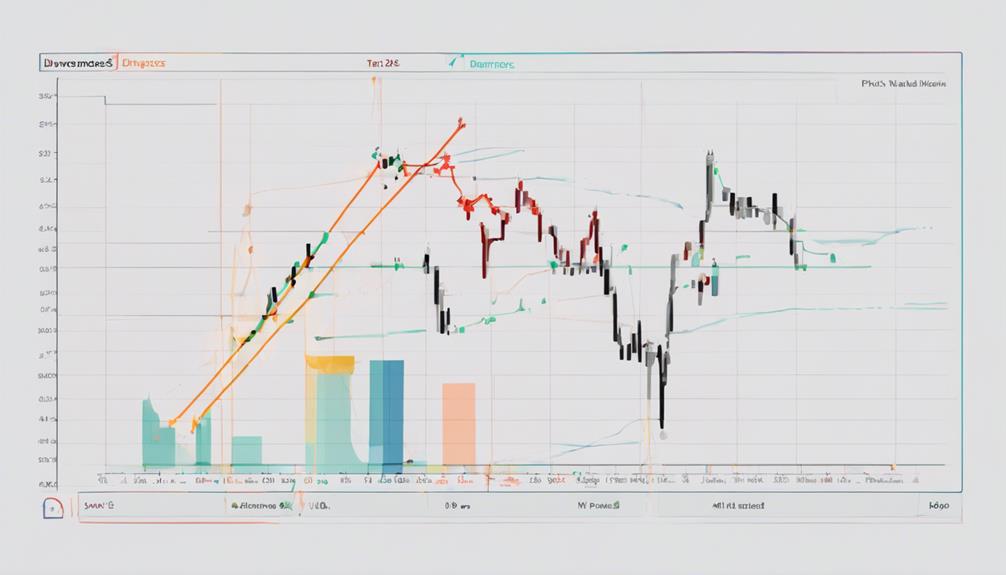
Divergence analysis within the context of the Trix indicator entails a meticulous comparison between the indicator's movements and price action, aiming to discern potential shifts in market trends. When conducting divergence analysis with TRIX, traders focus on identifying bullish and bearish divergences to anticipate trend reversals.
Here are key points to consider:
- Bullish divergence occurs when TRIX forms higher lows while prices make lower lows, suggesting a potential upward price movement.
- Bearish divergence is identified when TRIX shows lower highs as prices exhibit higher highs, indicating a possible downward price movement.
Divergence analysis helps traders anticipate changes in market direction by comparing TRIX signals with price movements. Recognizing divergences in TRIX provides valuable insights into market dynamics, aiding in the identification of potential trading opportunities.
Can You Explain the Key Features of the Trix Indicator in More Detail?
The trix indicator breakdown tutorial offers a comprehensive understanding of the key features of the Trix indicator. This tutorial delves into the intricacies of the indicator, providing detailed explanations of its components and how it can be used to analyze trends and spot potential trading opportunities.
Frequently Asked Questions
What Is the TRIX Indicator Strategy?
The TRIX indicator strategy involves utilizing the triple exponential moving average to pinpoint trends and momentum in the market. It aids traders in identifying potential trend reversals and generating buy or sell signals effectively.
Is Trix a Good Indicator?
Is TRIX a good indicator? TRIX offers valuable insights by filtering price noise, identifying trend reversals, and offering clear signals. Its basis on TEMA enhances responsiveness, making it a powerful tool for traders seeking reliable market analysis.
What Is the Trix Strategy in Tradingview?
The TRIX strategy in TradingView utilizes the TRIX indicator to detect trend reversals and trading opportunities. By monitoring the percentage change in the Triple Exponential Moving Average (TEMA), traders can identify momentum shifts and make informed decisions based on TRIX signals.
Is a Trix a Momentum Oscillator?
Yes, TRIX is indeed a momentum oscillator. It measures the rate of change of a triple exponential moving average, highlighting shifts in momentum. TRIX helps traders assess trend strength, identify overbought/oversold conditions, and spot potential trading opportunities with its zero-crossing signals.
Conclusion
In conclusion, the Trix Indicator offers traders a powerful tool to analyze price momentum and detect market trends effectively.
By utilizing its unique calculation method and signal generation mechanism, traders can identify both bullish and bearish signals, as well as potential divergences in the market.
As the saying goes, 'knowledge is power,' and understanding the key features of the Trix Indicator can provide traders with valuable insights to make informed trading decisions in the futures market.
